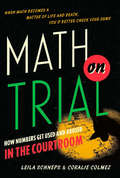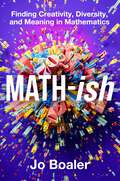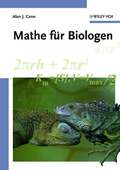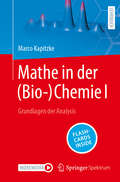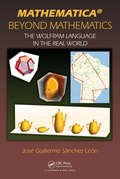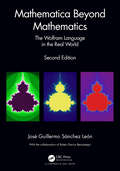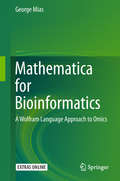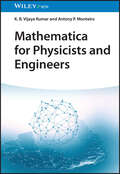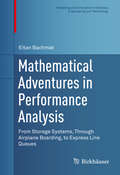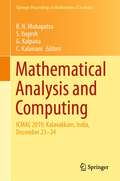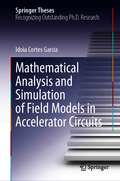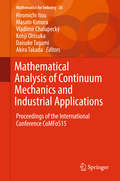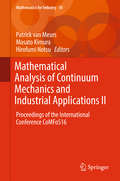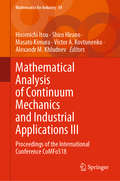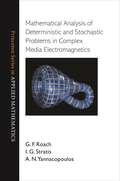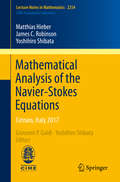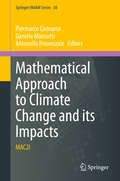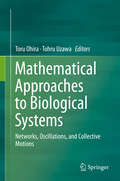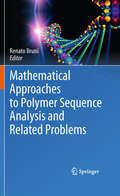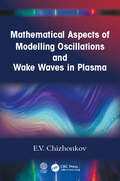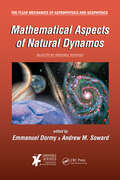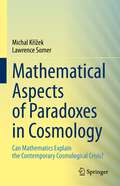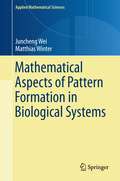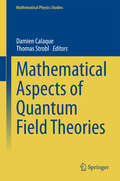- Table View
- List View
Math on Trial: How Numbers Get Used and Abused in the Courtroom
by Leila Schneps Coralie ColmezIn the wrong hands, math can be deadly. Even the simplest numbers can become powerful forces when manipulated by journalists, politicians or other public figures, but in the case of the law your libertyOCoand your lifeOCocan depend on the right calculation. "Math on Trial" tells the story of ten trials in which mathematical arguments were usedOCoand disastrously misusedOCoas evidence. Despite years of math classes, most people (and most jurors) fail to detect even simple mathematical sophistry, resulting in such horrors as a medical expertOCOs faulty calculation of probabilities providing the key evidence for a British motherOCOs conviction for the murder of her two babies. The conviction was later overturned, but three years in prison took its tollOCoSally Clark died of acute alcohol intoxication in March of 2007. Mathematicians Leila Schneps and Coralie Colmez use a wide range of examples, from a mid-19th-century dispute over wills that became a signal case in the forensic use of mathematics, to the conviction and subsequent exoneration of Amanda Knox, to show how the improper application of mathematical concepts can mean the difference between walking free and life in prison. The cases discussed include: -The Case of Amanda Knox (How a judgeOCOs denial of a second DNA test may have destroyed a chance to reveal the truth about Meredith KercherOCOs murder)-The Case of Joe Sneed (How a fabricated probability framed a son for his parentsOCO grisly killing)-The Case of Sally Clark (How multiplying non-independent probabilities landed an innocent mother in jail for the murder of her children)-The Case of Janet Collins (How unjustified estimates combined with a miscalculated probability convicted an innocent couple of violent robbery) A colorful narrative of mathematical abuse featuring such characters as Charles Ponzi, Alfred Dreyfus, Hetty Green, and Oliver Wendell Holmes, "Math on Trial" shows that legal expertise isnOCOt everything when it comes to proving a man innocent.
Math-ish: Finding Creativity, Diversity, and Meaning in Mathematics
by Jo BoalerFrom Stanford professor, author of Limitless Mind, youcubed.org founder, and leading expert in the field of mathematics education Jo Boaler comes a groundbreaking guide to finding joy and understanding by adopting a diverse approach to learning math.“Every once in a while, someone revolutionizes an approach to a difficult subject and changes it forever. That is what Jo Boaler has done for math. Fresh, smart, and inclusive, Jo Boaler's strategy eschews the one-size-fits-a-few approach and instead allows math to be seen and solved by everyone. A huge achievement. Math-ish is the only math book I’ve ever enjoyed reading in my entire life. Honestly.” -Bonnie Garmus, author of Lessons in ChemistryMathematics is a fundamental part of life, yet every one of us has a unique relationship with learning and understanding the subject. Working with numbers may inspire confidence in our abilities or provoke anxiety and trepidation. Stanford researcher, mathematics education professor, and the leading expert on math learning Dr. Jo Boaler argues that our differences are the key to unlocking our greatest mathematics potential.In Math-ish, Boaler shares new neuroscientific research on how embracing the concept of “math-ish”—a theory of mathematics as it exists in the real world—changes the way we think about mathematics, data, and ourselves. When we can see the value of diversity among people and multi-faceted approaches to learning math, we are free to truly flourish. Utilizing the latest research on math education, Jo guides us through seven principles that can radically reframe our relationship with the subject:• The power of mindset on learning• Utilizing a visual approach to math• The impact of physical movement and communication on understanding• Understanding the value of an "ish" perspective - in mathematics and beyond• The importance of connected and flexible knowledge• New data on diverse teaching modes that work with different learning styles, not against them• The value of diversity in learning mathematics—and beyondWhen mathematics is approached more broadly, inclusively, and with a greater sense of wonder and play—when we value the different ways people see, approach, and understand it—we empower ourselves and gain a beneficial understanding of its value in our lives.
Mathe für Biologen
by Alan J. CannUm ein biologisches Experiment richtig planen, durchf hren und auswerten zu k nnen, muss man ber fundierte Kenntnisse grundlegender mathematischer und statistischer Operationen verf gen. Mathe f r Biologen bietet einen leicht verst ndlichen Zugang zur Mathematik, Statistik und Datenverarbeitung. Ob in Form von Exponentialrechnungen, Logarithmen oder bei der Berechnung von Molarit ten, Verd nnungen und Volumina - ohne Mathematik geht im Labor gar nichts. Die Kenntnis aller relevanten Ma einheiten und Umrechnungsverh ltnisse ist ebenso unverzichtbar wie eine sichere Beherrschung der wichtigsten statistischen Methoden und der Prinzipien der Wahrscheinlichkeitsrechnung. All dies vermittelt Mathe f r Biologen. Besonders junge Wissenschaftler, Diplomanden, Doktoranden und Angeh rige des technischen Personals d rften die einf hlsame Didaktik, den klaren Aufbau und die verst ndliche Sprache des Bandes zu sch tzen wissen. Jedes der elf Kapitel enth lt Kontrollfragen, anhand derer der Leser seine Lernfortschritte berpr fen kann. Die L sungen werden im Anhang ausf hrlich hergeleitet und erl utert. Das umfangreiche Glossar erschlie t die wichtigsten Fachbegriffe. So empfiehlt sich der Band sowohl als Begleiter bei der t glichen Laborarbeit als auch zum Nachschlagen beim Verfassen wissenschaftlicher Arbeiten.
Mathe in der (Bio-)Chemie I: Grundlagen der Analysis
by Marco KapitzkeDer Übergang von der Schulmathematik zur Hochschulmathematik kann oft für Verwirrung und Unsicherheit sorgen. Dieses Buch wurde geschrieben, um Ihnen diesen Übergang so sanft wie möglich zu gestalten. Es ist speziell für Studienanfängerinnen und -anfänger der (Bio-) Chemie konzipiert, die Mathematik auf eine Art und Weise erklärt haben möchten, dass man sie versteht: kompakt, anschaulich und und gespickt mit zahlreichen Beispielrechnungen. Was Sie in diesem Buch erwartet: • Fundamentale mathematische Grundlagen • Algebraische Strukturen • Funktionen einer Veränderlichen • Komplexe Zahlen • Folgen, Reihen und Grenzwerte • Differenzial- und Integralrechnung Für wen ist dieses Buch geeignet? Neben Studierenden der (Bio-)Chemie eignet sich das Lehrbuch auch • für naturwissenschaftliche und technische Studiengänge mit Chemiebezug (beispielsweise Chemieingenieurwesen, Lebensmittelchemie, Chemietechnik, Biologie und Biotechnologie), • als Brückenkurs für Physikstudierende und • für interessierte Schülerinnen und Schüler.
Mathematica Beyond Mathematics: The Wolfram Language in the Real World
by José Guillermo Sánchez LeónAlthough many books have been written about Mathematica, very few of them cover the new functionality added to the most recent versions of the program. Mathematica Beyond Mathematics: The Wolfram Language in the Real World introduces the new features using real-world examples, based on the experience of the author as a consultant. In the process, you will also learn more about the Wolfram Language and how you can use it to solve a wide variety of problems. The author raises questions from a wide range of topics and answers them by taking full advantage of Mathematica's latest features. For example; What sources of energy does the world really use? How can we calculate tolerance limits in manufacturing processes? Are our cities getting warmer? Is the novel El Quijote written in Pi? How can we find planets outside our solar system?
Mathematica Beyond Mathematics: The Wolfram Language in the Real World
by José Guillermo Sánchez LeónAlthough many books have been written about Mathematica, very few of them cover the new functionality added to the most recent versions of the program. This thoroughly revised second edition of Mathematica Beyond Mathematics: The Wolfram Language in the Real World introduces the new features using real-world examples based on the experience of the author as a consultant and Wolfram certified instructor. The examples strike a balance between relevance and difficulty in terms of Mathematica syntax, allowing readers to incrementally build up their Mathematica skills as they go through the chapters While reading this book, you will also learn more about the Wolfram Language and how to use it to solve a wide variety of problems. The author raises questions from a wide range of topics and answers them by taking full advantage of Mathematica's latest features. For example: What sources of energy does the world really use? Are our cities getting warmer? Is the novel El Quixote written in Pi? Is it possible to reliably date the Earth using radioactive isotopes? How can we find planets outside our solar system? How can we model epidemics, earthquakes and other natural phenomena? What is the best way to compare organisms genetically? This new edition introduces the new capabilities added to the latest version of Mathematica (version 13), and discusses new topics related to machine learning, big data, finance economics, and physics. New to the Second Edition Separate sections containing carefully selected additional resources that can be accessed from either Mathematica or online Online Supplementary materials including code snippets used in the book and additional examples. Updated commands to take full advantage of Mathematica 13.
Mathematica for Bioinformatics: A Wolfram Language Approach To Omics
by George MiasThis book offers a comprehensive introduction to using Mathematica and the Wolfram Language for Bioinformatics. The chapters build gradually from basic concepts and the introduction of the Wolfram Language and coding paradigms in Mathematica, to detailed worked examples derived from typical research applications using Wolfram Language code. The coding examples range from basic sequence analysis, accessing genomic databases, differential gene expression, and machine learning implementations to time series analysis of longitudinal omics experiments, multi-omics integration and building dynamic interactive bioinformatics tools using the Wolfram Language. The topics address the daily bioinformatics needs of a broad audience: experimental users looking to understand and visualize their data, beginner bioinformaticians acquiring coding expertise in providing biological research solutions, and practicing expert bioinformaticians working on omics who wish to expand their toolset to include the Wolfram Language.
Mathematica for Physicists and Engineers
by K. B. Kumar Antony P. MonteiroMathematica for Physicists and Engineers Hands-on textbook for learning how to use Mathematica to solve real-life problems in physics and engineering Mathematica for Physicists and Engineers provides the basic concepts of Mathematica for scientists and engineers, highlights Mathematica’s several built-in functions, demonstrates mathematical concepts that can be employed to solve problems in physics and engineering, and addresses problems in basic arithmetic to more advanced topics such as quantum mechanics. The text views mathematics and physics through the eye of computer programming, fulfilling the needs of students at master’s levels and researchers from a physics and engineering background and bridging the gap between the elementary books written on Mathematica and the reference books written for advanced users. Mathematica for Physicists and Engineers contains information on: Basics to Mathematica, its nomenclature and programming language, and possibilities for graphic output Vector calculus, solving real, complex and matrix equations and systems of equations, and solving quantum mechanical problems in infinite-dimensional linear vector spaces Differential and integral calculus in one and more dimensions and the powerful but elusive Dirac Delta function Fourier and Laplace transform, two integral transformations that are instrumental in many fields of physics and engineering for the solution of ordinary and partial differential equations Serving as a complete first course in Mathematica to solve problems in science and engineering, Mathematica for Physicists and Engineers is an essential learning resource for students in physics and engineering, master’s students in material sciences, geology, biological sciences theoretical chemists. Also lecturers in these and related subjects will benefit from the book.
Mathematical Adventures in Performance Analysis
by Eitan Bachmat This book describes problems in the field of performance analysis, primarily the study of storage systems and the diverse mathematical techniques that are required for solving them. Topics covered include best practices for scheduling I/O requests to a disk drive, how this problem is related to airplane boarding, and how both problems can be modeled using space-time geometry. Also provided is an explanation of how Riemann's proof of the analytic continuation and functional equation of the Riemann zeta function can be used to analyze express line queues in a minimarket. Overall, the book displays the surprising relevance of abstract mathematics that is not usually associated with applied mathematics topics. Advanced undergraduate students or graduate students with an interest in the applications of mathematics will find this book to be a useful resource. It will also be of interest to professional mathematicians who want exposure to the surprising ways that theoretical mathematics may be applied to engineering problems. To encourage further study, each chapter ends with notes pointing to various related topics that the reader may want pursue. This mathematically rigorous work was noted in the news section of the journal Nature, and in popular media such as New Scientist, The Wall Street Journal, The Guardian, and USA Today.
Mathematical Analysis and Computing: ICMAC 2019, Kalavakkam, India, December 23–24 (Springer Proceedings in Mathematics & Statistics #344)
by R. N. Mohapatra S. Yugesh G. Kalpana C. KalaivaniThis book is a collection of selected papers presented at the International Conference on Mathematical Analysis and Computing (ICMAC 2019) held at Sri Sivasubramaniya Nadar College of Engineering, Chennai, India, from 23–24 December 2019. Having found its applications in game theory, economics, and operations research, mathematical analysis plays an important role in analyzing models of physical systems and provides a sound logical base for problems stated in a qualitative manner. This book aims at disseminating recent advances in areas of mathematical analysis, soft computing, approximation and optimization through original research articles and expository survey papers. This book will be of value to research scholars, professors, and industrialists working in these areas.
Mathematical Analysis and Simulation of Field Models in Accelerator Circuits (Springer Theses)
by Idoia Cortes GarciaThis book deals with the analysis and development of numerical methods for the time-domain analysis of multiphysical effects in superconducting circuits of particle accelerator magnets. An important challenge is the simulation of “quenching”, i.e. the transition of a material from the superconducting to the normally electrically conductive state. The book analyses complex mathematical structures and presents models to simulate such quenching events in the context of generalized circuit elements. Furthermore, it proposes efficient parallelized algorithms with guaranteed convergence properties for the simulation of multiphysical problems. Spanning from theoretical concepts to applied research, and featuring rigorous mathematical presentations on one side, as well as simplified explanations of many complex issues, on the other side, this book provides graduate students and researchers with a comprehensive introduction on the state of the art and a source of inspiration for future research. Moreover, the proposed concepts and methods can be extended to the simulation of multiphysical phenomena in different application contexts.
Mathematical Analysis of Continuum Mechanics and Industrial Applications
by Masato Kimura Hiromichi Itou Vladimír Chalupecký Kohji Ohtsuka Daisuke Tagami Akira TakadaThis book focuses on mathematical theory and numerical simulation related to various aspects of continuum mechanics, such as fracture mechanics, elasticity, plasticity, pattern dynamics, inverse problems, optimal shape design, material design, and disaster estimation related to earthquakes. Because these problems have become more important in engineering and industry, further development of mathematical study of them is required for future applications. Leading researchers with profound knowledge of mathematical analysis from the fields of applied mathematics, physics, seismology, engineering, and industry provide the contents of this book. They help readers to understand that mathematical theory can be applied not only to different types of industry, but also to a broad range of industrial problems including materials, processes, and products.
Mathematical Analysis of Continuum Mechanics and Industrial Applications II
by Masato Kimura Patrick Van Meurs Hirofumi NotsuAs the sequel to the proceedings of the International Conference of Continuum Mechanics Focusing on Singularities (CoMFoS15), the proceedings of CoMFoS16 present further advances and new topics in mathematical theory and numerical simulations related to various aspects of continuum mechanics. These include fracture mechanics, shape optimization, modeling of earthquakes, material structure, interface dynamics and complex systems. . The authors are leading researchers with a profound knowledge of mathematical analysis from the fields of applied mathematics, physics, seismology, engineering, and industry. The book helps readers to understand how mathematical theory can be applied to various industrial problems, and conversely, how industrial problems lead to new mathematical challenges.
Mathematical Analysis of Continuum Mechanics and Industrial Applications III: Proceedings of the International Conference CoMFoS18 (Mathematics for Industry #34)
by Masato Kimura Hiromichi Itou Shiro Hirano Victor A. Kovtunenko Alexandr M. KhludnevThis book focuses on mathematical theory and numerical simulation related to various areas of continuum mechanics, such as fracture mechanics, (visco)elasticity, optimal shape design, modelling of earthquakes and Tsunami waves, material structure, interface dynamics and complex systems. Written by leading researchers from the fields of applied mathematics, physics, seismology, engineering, and industry with an extensive knowledge of mathematical analysis, it helps readers understand how mathematical theory can be applied to various phenomena, and conversely, how to formulate actual phenomena as mathematical problems. This book is the sequel to the proceedings of the International Conference of Continuum Mechanics Focusing on Singularities (CoMFoS) 15 and CoMFoS16.
Mathematical Analysis of Deterministic and Stochastic Problems in Complex Media Electromagnetics (Princeton Series in Applied Mathematics #42)
by G. F. Roach I. G. Stratis A. N. YannacopoulosElectromagnetic complex media are artificial materials that affect the propagation of electromagnetic waves in surprising ways not usually seen in nature. Because of their wide range of important applications, these materials have been intensely studied over the past twenty-five years, mainly from the perspectives of physics and engineering. But a body of rigorous mathematical theory has also gradually developed, and this is the first book to present that theory. Designed for researchers and advanced graduate students in applied mathematics, electrical engineering, and physics, this book introduces the electromagnetics of complex media through a systematic, state-of-the-art account of their mathematical theory. The book combines the study of well posedness, homogenization, and controllability of Maxwell equations complemented with constitutive relations describing complex media. The book treats deterministic and stochastic problems both in the frequency and time domains. It also covers computational aspects and scattering problems, among other important topics. Detailed appendices make the book self-contained in terms of mathematical prerequisites, and accessible to engineers and physicists as well as mathematicians.
Mathematical Analysis of the Navier-Stokes Equations: Cetraro, Italy 2017 (Lecture Notes in Mathematics #2254)
by James C. Robinson Yoshihiro Shibata Matthias HieberThis book collects together a unique set of articles dedicated to several fundamental aspects of the Navier–Stokes equations. As is well known, understanding the mathematical properties of these equations, along with their physical interpretation, constitutes one of the most challenging questions of applied mathematics. Indeed, the Navier-Stokes equations feature among the Clay Mathematics Institute's seven Millennium Prize Problems (existence of global in time, regular solutions corresponding to initial data of unrestricted magnitude). The text comprises three extensive contributions covering the following topics: (1) Operator-Valued H∞-calculus, R-boundedness, Fourier multipliers and maximal Lp-regularity theory for a large, abstract class of quasi-linear evolution problems with applications to Navier–Stokes equations and other fluid model equations; (2) Classical existence, uniqueness and regularity theorems of solutions to the Navier–Stokes initial-value problem, along with space-time partial regularity and investigation of the smoothness of the Lagrangean flow map; and (3) A complete mathematical theory of R-boundedness and maximal regularity with applications to free boundary problems for the Navier–Stokes equations with and without surface tension. Offering a general mathematical framework that could be used to study fluid problems and, more generally, a wide class of abstract evolution equations, this volume is aimed at graduate students and researchers who want to become acquainted with fundamental problems related to the Navier–Stokes equations.
Mathematical Approach to Climate Change and its Impacts: MAC2I (Springer INdAM Series #38)
by Piermarco Cannarsa Antonello Provenzale Daniela MansuttiThis book presents important recent applied mathematics research on environmental problems and impacts due to climate change. Although there are inherent difficulties in addressing phenomena that are part of such a complex system, exploration of the subject using mathematical modelling is especially suited to tackling poorly understood issues in the field. It is in this spirit that the book was conceived. It is an outcome of the International INDAM Workshop “Mathematical Approach to Climate Change Impacts – MAC2I”, held in Rome in March 2017. The workshop comprised four sessions, on Ecosystems, Hydrology, Glaciology, and Monitoring. The book includes peer-reviewed contributions on research issues discussed during each of these sessions or generated by collaborations among the specialists involved. Accurate parameter determination techniques are explained and innovative mathematical modelling approaches, presented. The book also provides useful material and mathematical problem-solving tools for doctoral programs dealing with the complexities of climate change.
Mathematical Approaches to Biological Systems
by Toru Ohira Tohru UzawaThis book presents the most recent mathematical approaches to the growing research area of networks, oscillations, and collective motions in the context of biological systems. Bringing together the results of multiple studies of different biological systems, this book sheds light on the relations among these research themes. Included in this book are the following topics: feedback systems with time delay and threshold of sensing (dead zone), robustness of biological networks from the point of view of dynamical systems, the hardware-oriented neuron modeling approach, a universal mechanism governing the entrainment limit under weak forcing, the robustness mechanism of open complex systems, situation-dependent switching of the cues primarily relied on by foraging ants, and group chase and escape. Research on different biological systems is presented together, not separated by specializations or by model systems. Therefore, the book provides diverse perspectives at the forefront of current mathematical research on biological systems, especially focused on networks, oscillations, and collective motions. This work is aimed at advanced undergraduate, graduate, and postdoctoral students, as well as scientists and engineers. It will also be of great use for professionals in industries and service sectors owing to the applicability of topics such as networks and synchronizations.
Mathematical Approaches to Polymer Sequence Analysis and Related Problems
by Renato BruniAn edited volume describing the latest developments in approaching the problem of polymer sequence analysis, with special emphasis on the most relevant biopolymers (peptides and DNA) but not limited to them. The chapters will include peptide sequence analysis, DNA sequence analysis, analysis of biopolymers and nonpolymers, sequence alignment problems, and more.
Mathematical Aspects of Fluid Mechanics
by James C. Robinson José L. Rodrigo Witold SadowskiThe rigorous mathematical theory of the equations of fluid dynamics has been a focus of intense activity in recent years. This volume is the product of a workshop held at the University of Warwick to consolidate, survey and further advance the subject. The Navier–Stokes equations feature prominently: the reader will find new results concerning feedback stabilisation, stretching and folding, and decay in norm of solutions to these fundamental equations of fluid motion. Other topics covered include new models for turbulent energy cascade, existence and uniqueness results for complex fluids and certain interesting solutions of the SQG equation. The result is an accessible collection of survey articles and more traditional research papers that will serve both as a helpful overview for graduate students new to the area and as a useful resource for more established researchers.
Mathematical Aspects of Modelling Oscillations and Wake Waves in Plasma
by E. V. ChizhonkovThis book is devoted to research in the actual field of mathematical modeling in modern problems of plasma physics associated with vibrations and wake waves excited by a short high-power laser pulse. The author explores the hydrodynamic model of the wake wave in detail and from different points of view, within the framework of its regular propagation, a development suitable for accelerating electrons, and the final tipping effect resulting in unregulated energy transfer to plasma particles. Key selling features: Presents research directly related to the propagation of super-power short laser pulses (subject of the 2018 Nobel Prize in Physics). Presents mathematical modeling of plasma physics associated with vibrations and wake waves excited by a short high-power laser pulse. Includes studies of large-amplitude plasma oscillations. Most of the presented results are of original nature and have not appeared in the domestic and foreign scientific literature Written at a level accessible for researchers, academia, and engineers.
Mathematical Aspects of Natural Dynamos (The Fluid Mechanics of Astrophysics and Geophysics)
by Andrew M. Soward Emmanuel DormyAlthough the origin of Earth's and other celestial bodies' magnetic fields remains unknown, we do know that the motion of electrically conducting fluids generates and maintains these fields, forming the basis of magnetohydrodynamics (MHD) and, to a larger extent, dynamo theory. Answering the need for a comprehensive, interdisciplinary introduction
Mathematical Aspects of Paradoxes in Cosmology: Can Mathematics Explain the Contemporary Cosmological Crisis?
by Michal Křížek Lawrence SomerThis book provides a mathematical and numerical analysis of many problems which lead to paradoxes in contemporary cosmology, in particular, the existence of dark matter and dark energy. It is shown that these hypothetical quantities arise from excessive extrapolations of simple mathematical models to the whole physical universe. Written in a completely different style to most books on General Relativity and cosmology, the important results take the form of mathematical theorems with precise assumptions and statements. All theorems are followed by a corresponding proof, or an exact reference to the proof.Some nonstandard topics are also covered, including violation of the causality principle in Newtonian mechanics, a critical mathematical and numerical analysis of Mercury's perihelion shift, inapplicability of Einstein's equations to the classical two-body problem due to computational complexity, non-uniqueness of the notion of universe, the topology of the universe, various descriptions of a hypersphere, regular tessellations of hyperbolic spaces, local Hubble expansion of the universe, neglected gravitational redshift in the detection of gravitational waves, and the possible distribution of mass inside a black hole. The book also dispels some myths appearing in the theory of relativity and in contemporary cosmology. For example, although the hidden assumption that Einstein's equations provide a good description of the evolution of the whole universe is considered to be obvious, it is just a null hypothesis which has not been verified by any experiment, and has only been postulated by excessive extrapolations of many orders of magnitude.
Mathematical Aspects of Pattern Formation in Biological Systems
by Juncheng Wei Matthias WinterThis monograph is concerned with the mathematical analysis of patterns which are encountered in biological systems. It summarises, expands and relates results obtained in the field during the last fifteen years. It also links the results to biological applications and highlights their relevance to phenomena in nature. Of particular concern are large-amplitude patterns far from equilibrium in biologically relevant models. The approach adopted in the monograph is based on the following paradigms: * Examine the existence of spiky steady states in reaction-diffusion systems and select as observable patterns only the stable ones * Begin by exploring spatially homogeneous two-component activator-inhibitor systems in one or two space dimensions * Extend the studies by considering extra effects or related systems, each motivated by their specific roles in developmental biology, such as spatial inhomogeneities, large reaction rates, altered boundary conditions, saturation terms, convection, many-component systems. Mathematical Aspects of Pattern Formation in Biological Systems will be of interest to graduate students and researchers who are active in reaction-diffusion systems, pattern formation and mathematical biology.
Mathematical Aspects of Quantum Field Theories
by Damien Calaque Thomas StroblDespite its long history and stunning experimental successes, the mathematical foundation of perturbative quantum field theory is still a subject of ongoing research. This book aims at presenting some of the most recent advances in the field, and at reflecting the diversity of approaches and tools invented and currently employed. Both leading experts and comparative newcomers to the field present their latest findings, helping readers to gain a better understanding of not only quantum but also classical field theories. Though the book offers a valuable resource for mathematicians and physicists alike, the focus is more on mathematical developments. This volume consists of four parts: The first Part covers local aspects of perturbative quantum field theory, with an emphasis on the axiomatization of the algebra behind the operator product expansion. The second Part highlights Chern-Simons gauge theories, while the third examines (semi-)classical field theories. In closing, Part 4 addresses factorization homology and factorization algebras.
